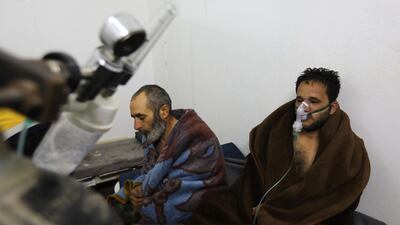The global chemical weapons agency said on Wednesday that chlorine was "likely used as a chemical weapon" in a February attack in Saraqeb in the northwestern Syrian province of Idlib.
The Organisation for the Prohibition of Chemical Weapons (OPCW) said laboratory tests had confirmed the presence of chlorine. However, in line with its mandate, the agency did not say which side used the banned munitions.
"Chlorine was released from cylinders by mechanical impact in the Al Talilneighbourhood of Saraqeb" on February 4, said a statement by The Hague-based organisation.
The team’s conclusions were based on finding two cylinders “which were determined as previously containing chlorine”.
The watchdog added that environmental samples also “demonstrated the usual presence of chlorine in the local environment”.
____________
Read more
UN probing suspected use of chlorine gas by Syrian regime
Are chemical weapons now a long-term threat to the Mideast
____________
The Britain-based Syrian Observatory for Human Rights said that 11 people were treated for “suffocation” on February 4 after Syrian government strikes on Saraqeb. Mohammad Ghaleb Tannari, a doctor in a nearby town in Idlib province, also told AFP at the time that his hospital had treated 11 people.
"All the cases we received had symptoms consistent with inhaling the toxic chlorine gas, including exhaustion, difficulty breathing, and coughing," he said.
The OPCW said its team had interviewed witnesses, and found that a "number of patients at medical facilities shortly after the incident showed signs and symptoms consistent with exposure to chlorine”.
"I strongly condemn the use of toxic chemicals as weapons by anyone, for any reason, and in any circumstances," said OPCW head Ahmet Uzumcu.
"Such acts contradict the unequivocal prohibition against chemical weapons."
An OPCW fact-finding team is also currently awaiting the results of its difficult mission to the Syrian town of Douma, after medics and rescuers said 40 people died in a chlorine and sarin attack on April 7.
The team exhumed bodies as well as gathering over 100 environmental samples which are being analysed in different OPCW-designated labs.
Syria and Russia have accused Syrian volunteer rescue workers of staging the 7 April video footage at the behest of the United States and its allies.
Meanwhile on Wednesday state television reported that the remaining fighters in the last rebel-held enclave in central Syria were starting to withdraw, sealing the government's control over the area and opening a major stretch of the country's most important highway.
It further cements President Bashar Al Assad's dominant position over the most populated parts of Syria after years of fighting, but means any new military campaign might risk direct conflict with foreign powers.
The withdrawal may also be the last in a series of agreed evacuations used by the government to defeat besieged insurgents by forcing them to surrender territory in return for safe passage to opposition areas in the north.

